Inlay
Inlay covers a range of techniques in sculpture and the decorative arts for inserting pieces of contrasting, often coloured materials into depressions in a base object to form ornament or pictures that normally are flush with the matrix.[1] A great range of materials have been used both for the base or matrix and for the inlays inserted into it. Inlay is commonly used in the production of decorative furniture, where pieces of coloured wood, precious metals or even diamonds are inserted into the surface of the carcass using various matrices including clearcoats and varnishes. Lutherie inlays are frequently used as decoration and marking on musical instruments, particularly the smaller strings.
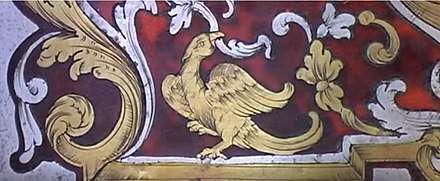

Perhaps the most famous example of furniture inlay is that of Andre-Charles Boulle (11 November 1642 – 28 February 1732) which is known as Boulle Work and evolved in part from inlay produced in Italy during the late 15th century at the Studiolo for Federico da Montefeltro in his Ducal Palace at Urbino, in which trompe-l'oeil shelving seems to carry books, papers, curios and mathematical instruments, in eye-deceiving perspective. The similar private study made for him at Gubbio is now in the Metropolitan Museum of Art.
Inlay in wood

In a wood matrix, inlays commonly use wood veneers, but other materials like shells, mother-of-pearl, horn or ivory may also be used. Pietre dure, or coloured stones inlaid in white or black marbles, and inlays of precious metals in a base metal matrix are other forms of inlay. Master craftsmen who make custom knives continue a tradition of ancient techniques of inlaying precious metals; additionally, many new techniques which use contemporary tools have also been developed and utilized as well by artisans.
Intarsia inlay in wood furniture differs from marquetry, a similar technique that largely replaced it in high-style European furniture during the 17th century,[2] in that marquetry is an assembly of veneers applied over the entire surface of an object, whereas inlay consists of small pieces inserted on the bed of cut spaces in the base material, of which most remains visible.
Inlay on metals
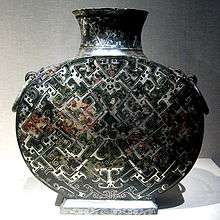
The history of inlay is very old but it is still evolving alongside new technologies and new materials being discovered today. The technique of metal in metal inlay was sophisticated and accomplished in ancient China as shown in examples of vessels decorated with precious metals including this ding vessel (pictured) with gold and silver inlay from the Warring States period (403-221 BC).
The French cabinet maker Andre-Charles Boulle (1642-1732) specialised in furniture using inlays or metal and either wood or tortoiseshell together, the latter acting as the background. This type of inlay is known as "Boulle Work".
After learning the skill of smithing from the Navaho in 1872, the Zuni silversmiths cut small chips from crystals and gemstones, pearl shell and coral, to make inlay designs in a base of silver.
In 1990, Vivienne Westwood was inspired by Boulle Work, the inlay of precious metals into or onto wood to create a collection with inlay in the manner of André-Charles Boulle.
In 2016, a subsidiary company of Jean-Raymond Boulle discovered and has filed a patent[8] for a new type of diamond inlay in keeping with Boulle Work, subsequently produced by AkzoNobel for application on cars,[9][10] planes[11][12] and yachts.[13]
The Inlaid Brass Ewer, signed by ʿAli ibn ʿAbdallah al-ʿAlawi, currently sits at the Museum of Islamic Art at the Pergamon Museum in Berlin, Germany. This 35 centimeter high jug can be dated back to the 13th century, during the Ayyubid dynasty, from about 1251-1275. It was produced in Mosul, in northern Iraq, a place that was known for its beautiful metalwork.The Inlaid Brass Ewer was used along with a basin, also signed by ʿAli ibn ʿAbdallah al-ʿAlawi, and both were most likely owned by a member of the higher class to wash their hands before dining at court. This ewer, along with a group of other inlaid brasses, can be associated with Mosul because of the abundance of artist signatures.
Technical Evaluation: The workshops of Mosul were known to have the finest bronzes, including ewers, basins, candlesticks, and others. These bronzes were inlaid with silver and gold, and were decorated with intricate designs and inscriptions. While the technique of metalworking originated in Persia, the trade routes in Mosul shaped it. The earliest use of metalworking was with copper, but with the addition of zinc, copper became brass. In Islamic areas, brass was used to make large braziers and dishes, but soon became proficient in creating ewers, basins, and other bronzes. These would then be decorated with gold and silver through the technique of inlaying. The process of inlaying a precious metal on top of a less precious one is evident on most of the bronzes that came from Mosul. A group of craftsman centered in Mosul created the Mosul school, which created an improved way of inlaying metals. This technique would bypass the earlier method of inlaying, especially when it came to silver. Strips of silver and gold were placed on undercut bronze and brass pieces in a way that when finished would show no irregularity. This technique was later brought to other cities, including Damascus. The technique of Damascene, named after the city of Damascus, involved the metal being inlaid to be softer than the substrate metal; the look was created by hammering the metal into an undercut hard metal. By hammering in strips of gold and silver, the brass ewers had predetermined patterns that were decorated. The Inlaid Brass Ewer's patterns and inscriptions include thrones, riders, and planets with their zodiac signs, and are inlaid with silver and gold. The motifs and metal choices are very common for Mosul metalwork.[14]
Inlay in stone
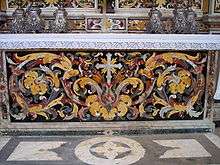
Pietra dura is the usual term in Europe for detailed inlays in contrasting colours of stones, including many semi-precious types; parchin kari is an Indian term. Pietra dura developed from the Roman Opus sectile, which was typically used on a larger scale, especially in floors. Cosmatesque work on walls and floors, and smaller objects, was a medieval intermediate stage, continuing ancient opus alexandrinum.
Inlaid artefacts have come down to us from the Ancient Mayan civilisation, among them, jade, mother of pearl and onyx inlaid into stone during the era that arts reached a peak during the seven centuries from 200 to 900 AD.
Inlay on fabrics
Vivienne Westwood created her Portrait Collection based on the furniture of Andre Charles Boulle.[15]
Gallery
 Pre-Dynastic Egyptian bone figure with eyes inlaid in lapis lazuli; inlaid eyes are found in sculpture from many periods
Pre-Dynastic Egyptian bone figure with eyes inlaid in lapis lazuli; inlaid eyes are found in sculpture from many periods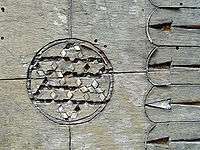 Decaying wood inlay on a chest in a Greek monastery.
Decaying wood inlay on a chest in a Greek monastery.- Ding bronze vessel with gold and silver inlay (Damascening) from the Warring States period (403–221 BC) of ancient China (c. 300 BC)
 Egyptian bone plaque of a putto, with wax inlay, 4th century
Egyptian bone plaque of a putto, with wax inlay, 4th century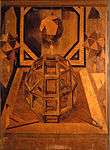 Geometric figure (1537) in wood intarsia by Fra Damiano da Bergamo, Bologna, Italy
Geometric figure (1537) in wood intarsia by Fra Damiano da Bergamo, Bologna, Italy- Parchin kara (pietra dura) in stone on the Taj Mahal
- Marquetry casket, Ottoman Empire (Istanbul or North Africa), 17th–18th century, wood, tortoise shell, bone, ivory Inlay.
 J. Paul Getty Museum: André-Charles Boulle 1710 Boulle Work inlay
J. Paul Getty Museum: André-Charles Boulle 1710 Boulle Work inlay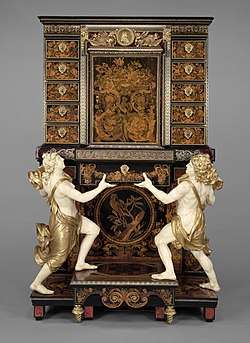 The J. Paul Getty Museum. André-Charles Boulle 1675–1680; Boulle Work inlay Paris, France.
The J. Paul Getty Museum. André-Charles Boulle 1675–1680; Boulle Work inlay Paris, France. J. Paul Getty Museum André-Charles Boulle Boulle Work inlay
J. Paul Getty Museum André-Charles Boulle Boulle Work inlay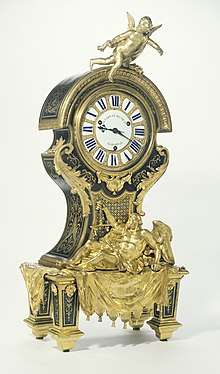
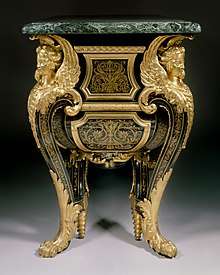 Commode André-Charles Boulle, son of Jean Boulle: (c. 1710–20). Boulle Work brass, tortoiseshell Inlay.
Commode André-Charles Boulle, son of Jean Boulle: (c. 1710–20). Boulle Work brass, tortoiseshell Inlay.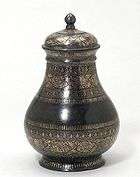 Bidriware cup and lid, c. 1850
Bidriware cup and lid, c. 1850
V&A Museum.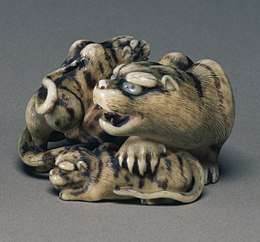 Japanese netsuke in ivory with ink; the eyes are inlaid in shell. 19th century
Japanese netsuke in ivory with ink; the eyes are inlaid in shell. 19th century.jpg) Egyptian basin with silver inlay
Egyptian basin with silver inlay
(Walters Art Museum)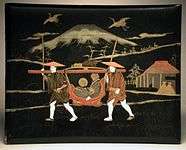 Japanese lacquerware Photograph Album Cover with ivory inlay, 1865
Japanese lacquerware Photograph Album Cover with ivory inlay, 1865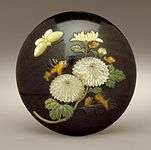 Japanese: late 19th century, wood with ivory, tortoiseshell, mother-of-pearl inlays; manjū type
Japanese: late 19th century, wood with ivory, tortoiseshell, mother-of-pearl inlays; manjū type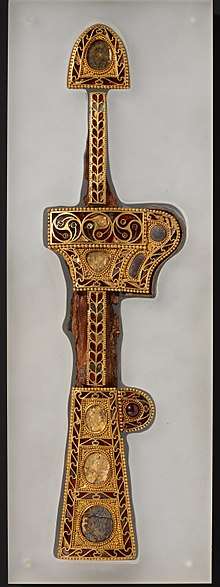 Gyerim-ro dagger and sheath, probably originating from the Black Sea region and discovered in a tomb from Silla Kingdom (c. 57 BCE – 935 CE), South Korea. Gyeongju National Museum, Gyeongju.
Gyerim-ro dagger and sheath, probably originating from the Black Sea region and discovered in a tomb from Silla Kingdom (c. 57 BCE – 935 CE), South Korea. Gyeongju National Museum, Gyeongju.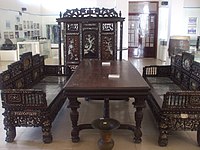 Mother of pearls inlaid furniture set in An Giang Museum, Vietnam.
Mother of pearls inlaid furniture set in An Giang Museum, Vietnam.
Notes
- Oxford Companion to the Decorative Arts, 1975, s.v. "Inlay", "Wood-working (Special Techniques)".
- John Fleming and Hugh Honour, The Penguin Dictionary of Decorative Arts (1977) s.v. "Inlay".
- "Jean Boulle Luxury Sun King® Diamonds Lining a Bentley in Monaco". EBL NEWS. Retrieved 20 April 2017.
- "Jean Boulle Luxury Sun King® Diamond inlay on a Bentley in Monaco" (PDF). Jean Boulle Luxury. Retrieved 20 March 2017.
- "Jean Boulle Luxury Sun King® inlay at Top Marques Monaco 2017". SG News.
- "Jean Boulle Luxury at Top Marques Monaco". Top Marques, Monaco. Retrieved 19 March 2017.
- "Jean Boulle Luxury's proprietary natural Gem diamond inlay exhibited". Investors Africa. Retrieved 23 March 2017.
- "Oceanco's-project Lumen shines with revolutionary Sun King® coating made from diamonds". Oceanco, line 2.
- "Bentley Azure painted with two million diamonds". News 18.
- "Jean Boulle: Diamond Luxury at Greater Heights". Aviation Week.
- "Jean Boulle Luxury Launches the World's First Aircraft Finished with the Sun King™ Natural Gem Diamond Coating at EBACE 2017". Aviation Week.
- "Jean Boulle: Diamond Luxury at Greater Heights". Aviation Week.
- "The Oceanco Lumen is a Superyacht Literally Bedazzled in Diamonds". RobbReport.
- http://www.kgnmarbleinlay.com/blog-post-history-of-brass-inlay.html
- "Vivienne Westwood 1990 A/W Collection : Portrait". Retrieved 23 March 2009.
External links
| Wikimedia Commons has media related to Inlay (art). |
- Contemporary Wall Art Marquetry - New technics
- Luigi Nebuloni's Personal Page Modern inlay painting
- Difference between Indian Classic Inlay and Italian Pietra Dura "Parchinkari"
- Taraceas Spanish wood inlays
- Marble Inlay Brass Inlay Inlay on Metals

